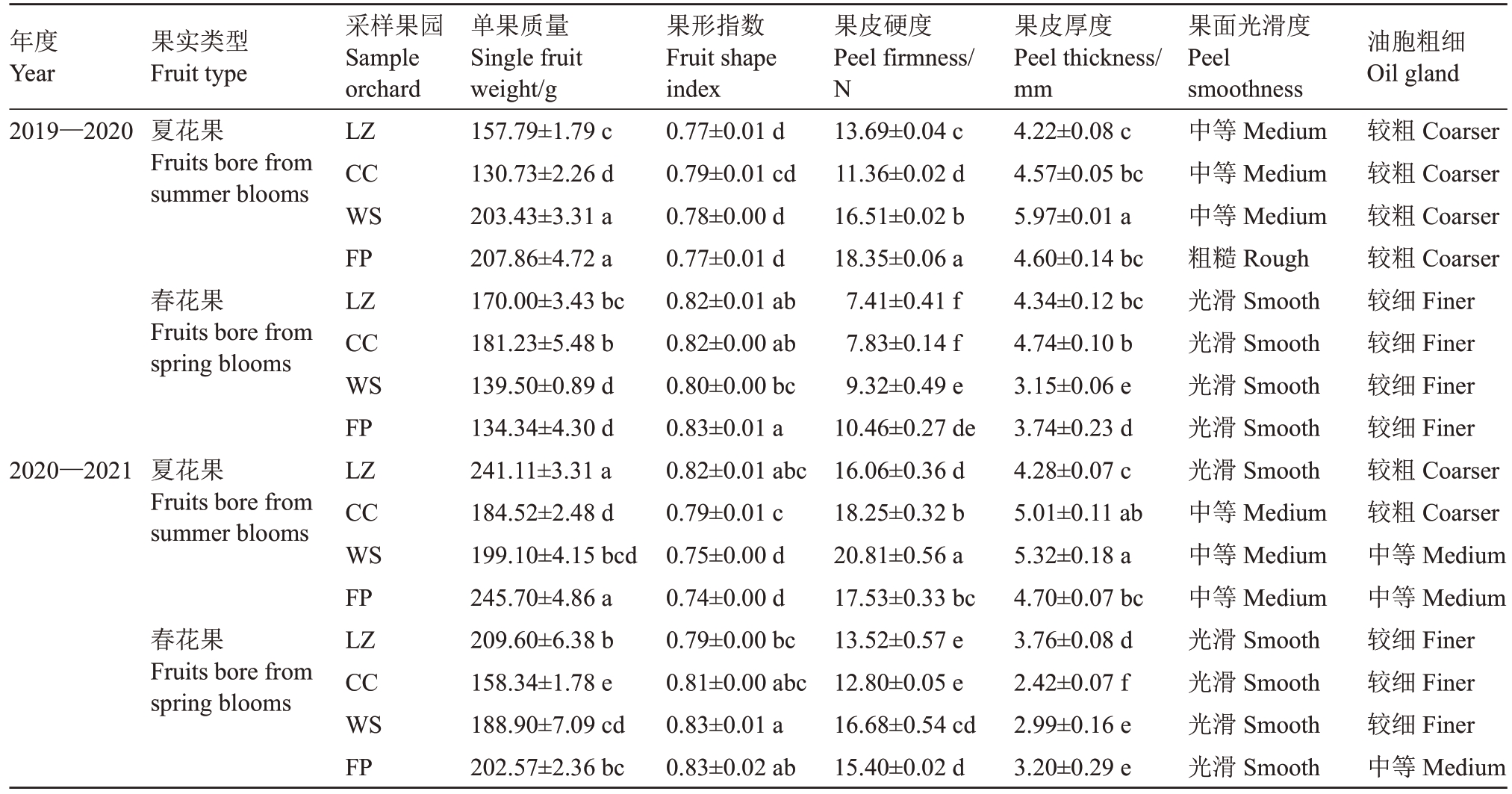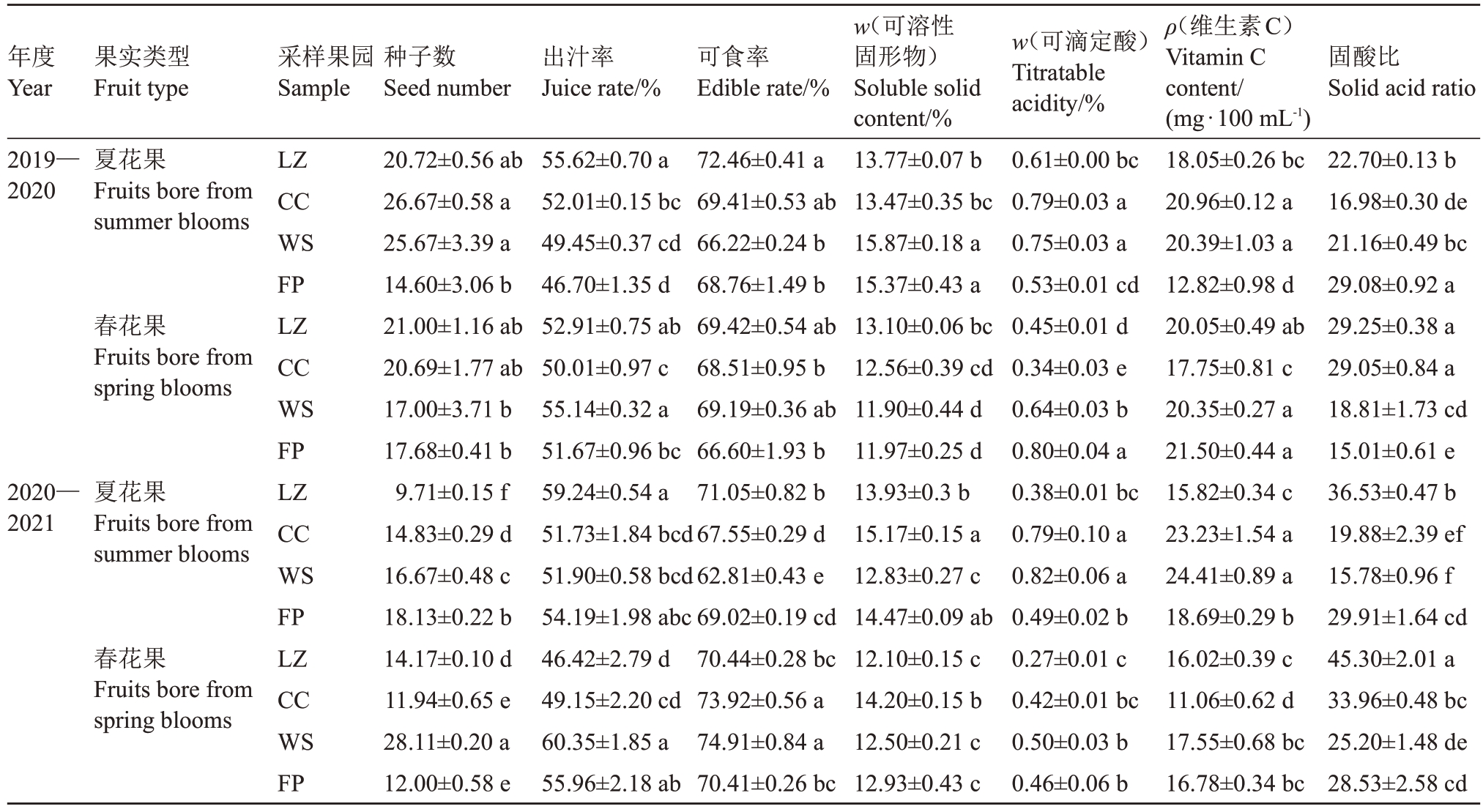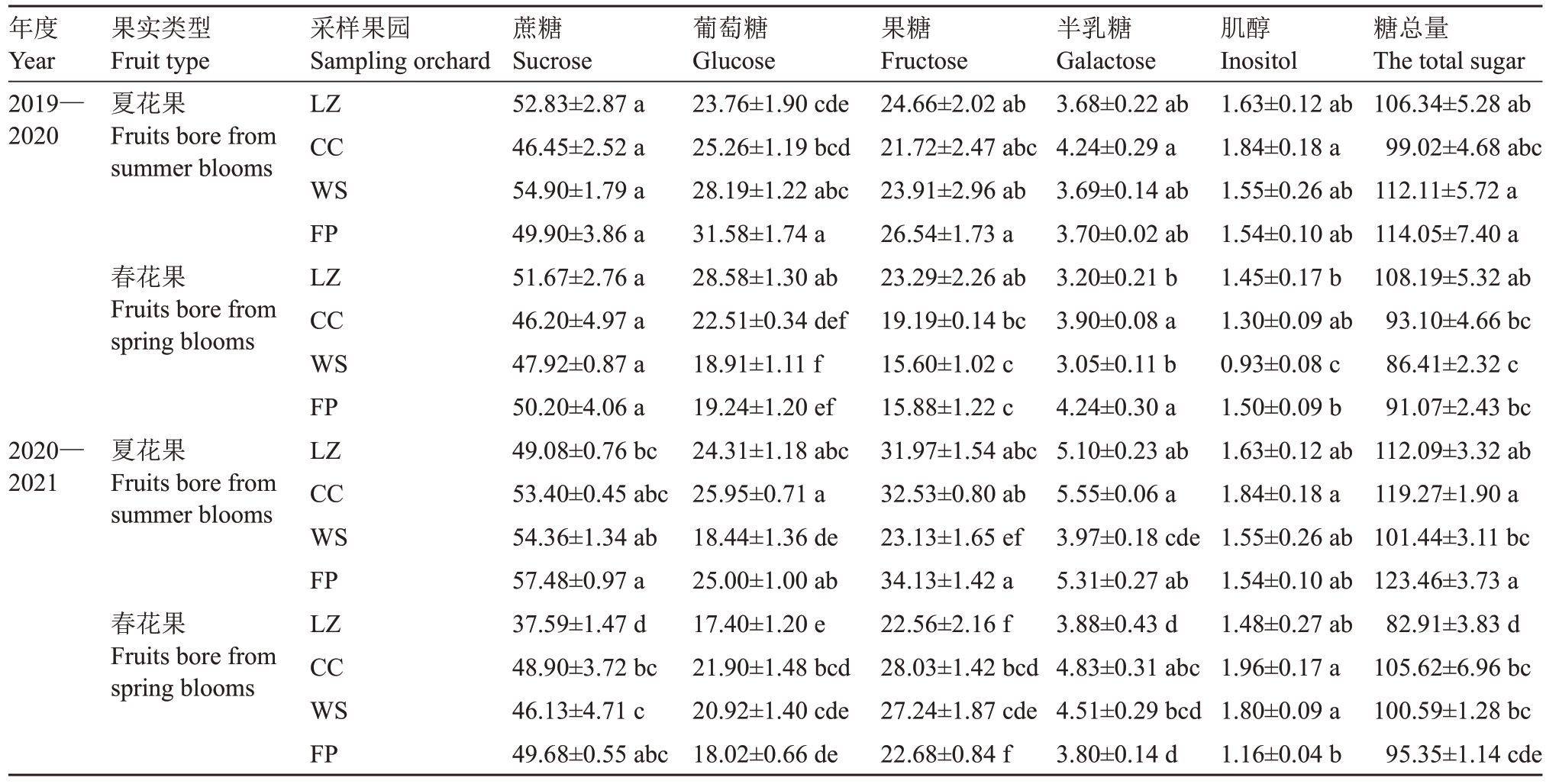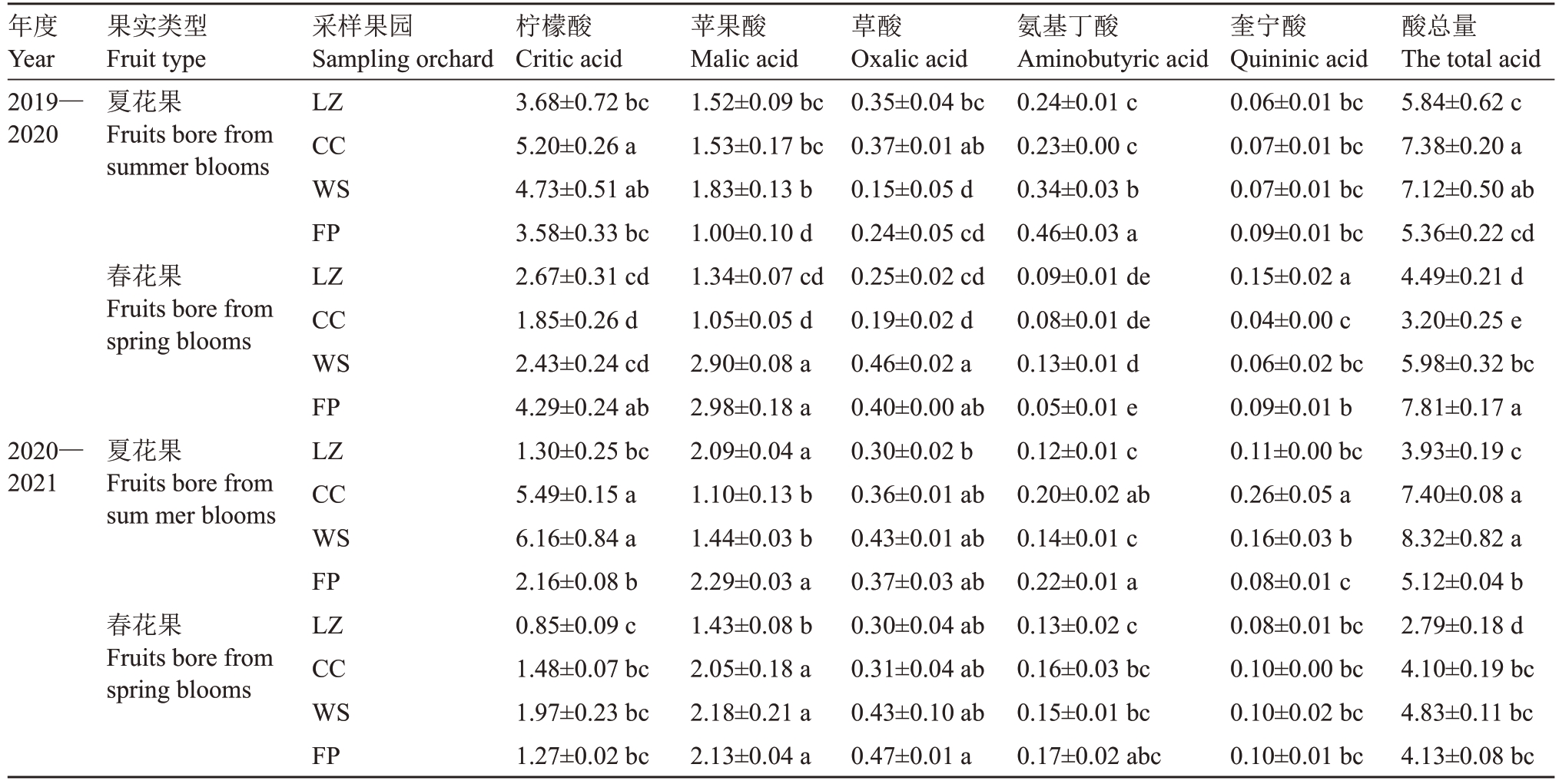果树的二次开花现象在柑橘、葡萄、苹果、梨、桃、李、石榴、蓝莓以及杨桃等树种上都会发生[1-6]。二次开花既受遗传特性影响,也受外界环境调控。柑橘类的柠檬、金柑、四季橘和枸橼在遗传上属于容易成花的类型,每批新梢都可能开花,而柑、橘、橙、柚类通常只有春季一次开花,仅在干旱等特定条件下才偶有二次开花[2,7]。多数果树二次开花所结果实质量不佳。例如,梨和苹果的二次花果实小且不能正常成熟;金柑类的夏花和秋花果实小,商品性差;温州蜜柑、不知火橘橙的夏花或秋花果实异常粗皮味淡,没有商品价值。因此,果树生产中通常控制二次或多次开花[7-9],只有葡萄、柠檬等少数品种利用其多次开花特性,生产错季或反季果品,延长采收期或错峰上市[2,7,10-12]。
沃柑(Orah mandarin)是坦普尔橘橙(Temple tangor)与丹西红橘(Dancy tangerine)杂交而来,具有晚熟、丰产、优质、耐贮等优良特性[13],近年在我国得到快速发展,全国已种植近20万hm2[14-15]。沃柑还具有易成花的特点,除在春季第一次开花外,也较易在夏季第二次开花,此现象在我国云南较为常见,生产上习惯抹除夏花和摘除夏花果。然而,近年发现沃柑的夏花果外观和内质都表现良好,这与温州蜜柑、不知火等品种夏花果的粗皮味淡截然不同。因此,我国云南一些沃柑园在夏花果较多时会保留夏花果在翌年夏季采收上市。但是,目前有关沃柑夏花果的研究尚处于空白,不利于了解其特点和生产指导。品质是果实最重要的研究对象和商品指标,其形成受外界因素影响[7,12,16],不同生态环境下的沃柑夏花果质量好坏、与春花果差异大小等还不得而知。为此,笔者在沃柑较易二次开花的云南亚热带山地和热带山地开展夏花果与春花果的形态、品质参数、糖酸组分以及口感风味等品质指标的系统性对比分析,以期为沃柑夏花果的利用提供参考。
1 材料和方法
1.1 试验材料
云南沃柑主要分布在亚热带山地和热带山地2个典型气候区,试验在这2个典型气候区的4个沃柑园进行:新平县平甸乡的励志沃柑园和传承沃柑园为亚热带山地气候,西双版纳州的勐海王氏沃柑园和景洪发平沃柑园为热带山地气候,4 个果园均为资阳香橙砧。新平2 个果园海拔分别为1330 m 和1450 m,2014年定植,山地黄壤,pH值5.1~5.3;勐海和景洪果园海拔分别为1400 m 和850 m,2016 年定植,黄红壤,pH 值5.5~5.7。新平县城海拔1470 m,年均温16~18 ℃,≥10 ℃积温5500~6300 ℃,5—6月降雨量210~260 mm;勐海县城海拔1700 m,年均温18~19 ℃,≥10 ℃积温4300~4600 ℃,5—6月降雨量89~400 mm;景洪市区海拔580 m,年均温20~23 ℃,≥10 ℃积温7300~8000 ℃,5—6 月降雨量120~450 mm。4个果园均采用或参照褚橙果园的技术方案[17],栽培管理方法基本相同。
每个试验果园在采样区保留夏花和夏花果,用于2019—2020 年度及2020—2021 年度的春花果和夏花果采样分析。新平2 个果园春花在3 月上旬初花,夏花在5月中旬初花,春花果和夏花果分别在翌年2月中旬和5月下旬调查采样;勐海和景洪果园春花分别在3月上旬和2月中旬初花,夏花分别在5月中旬和上旬初花,春花果和夏花果分别在翌年2 月中下旬和6月上旬调查采样。每次在每个果园选结果量中等的沃柑树,采集树冠外围4 个方向和中部的果实各1 个,3 株树共15 个果为1 个样品,每个果园采集3 个样品重复用于品质分析,另外采集部分果实样品用于口感鉴定和室内常温存放试验。
1.2 试验方法
1.2.1 果实常规品质测定 使用游标卡尺测量果实纵横径、果皮厚度,电子天平称质量。果皮光滑度和油胞粗细参照NY/T 2435—2013 进行评价[18]。种子数、出汁率及可食率参照GB 8210—87 的方法测定。用KONICA MINOLTA 的CR-400 色差计测定果皮色差。果实硬度采用硬度计(艾德堡GY-4,探头直径3.5 mm)测定,可溶性固形物(total soluble solid,TSS)含量采用爱拓ATAGO PAL-1 折射计测定,总酸(total acid,TA)含量采用NaOH 滴定法测定[19],维生素C(Vc)含量采用2,6-二氯酚靛酚法测定[20]。固酸比用可溶性固形物含量与总酸含量的比值表示。
1.2.2 果实糖代谢组分测定 采用岛津GC-MS 2010PLUS 气相色谱仪对果实糖代谢组分进行测定;样品制备参照朱攀攀[21]的方法,测定条件参照He等[22]的方法,分流比改为80∶1。
1.2.3 口感鉴定与贮运性 参考Obenland等[23]的方法对果实感官进行评价,鉴品小组由14名研究生和5 名教师共19 人组成,2020—2021 年度夏花果样品全部到达后,从每个果园的样品中随机选10个果切瓣进行感官品尝测试。风味口感评价分为:1,差;2,一般;3,良;4,优。另外,每个果园选4~5 kg无损伤夏花果置纸箱内在室内进行常温[(26±0.5)℃]贮藏试验至7月10日,了解异味情况。
1.3 数据处理与分析
采用Microsoft Office Excel 2016 对数据进行整理并作图;使用SPSS IBM SPSS Statistics 23.0 进行方差分析及多重比较,采用单因素ANOVA 分析的最小显著性差异法(least-significant difference,LSD)比较差异的显著水平(α=0.05),表中数据以(平均值±标准误)表示。
2 结果与分析
2.1 夏花果与春花果外在品质比较
表1 结果显示,总体上,2 个年度4 个果园的沃柑夏花果单果质量、果皮厚度、硬度显著高于春花果,夏花果比春花果稍扁,果面也稍粗糙。L值表示色泽亮度,表2结果显示,2019—2020年度多数夏花果L 值低于春花果,而2020—2021 年度多数夏花果L值高于春花果,仅景洪未达到显著差异水平。a*值代表红绿色差,夏花果红色浅,其a*值显著低于春花果。b*值代表黄蓝色差,勐海王氏和景洪发平夏花果b*值均低于春花果,而新平励志和传承的夏花果b*值整体高于春花果。C 值是色彩饱和度,多数夏花果的C 值显著低于春花果。H 值是色相角,从0~180 依次分为紫、红、橙、黄、黄绿、绿、蓝绿色,夏花果H 值显著高于春花果,且接近90。整体上,夏花果和春花果亮度均较高,红色浅且偏黄色。
表1 沃柑夏花果与春花果外在品质比较
Table 1 Comparison of external quality of Orah manderin fruits bore from summer and spring blooms

注:LZ. 新平励志;CC. 新平传承;WS. 勐海王氏;FP. 景洪发平。同列数据后不同小写字母表示差异显著(p<0.05)。下同。
Note:LZ.Lizhi orchard of Xinping county;CC.Chuancheng orchard of Xinping county; WS.Wangsi orchard of Menghai county;FP.Faping orchard of Jinghong city,Yunnan province.Different lowercase letters in the same column indicated significant differences(p<0.05).The same below.
油胞粗细Oil gland较粗Coarser较粗Coarser较粗Coarser较粗Coarser较细Finer较细Finer较细Finer较细Finer较粗Coarser较粗Coarser中等Medium中等Medium较细Finer较细Finer较细Finer中等Medium年度Year 2019—2020果实类型Fruit type夏花果Fruits bore from summer blooms春花果Fruits bore from spring blooms 2020—2021夏花果Fruits bore from summer blooms春花果Fruits bore from spring blooms采样果园Sample orchard LZ CC WS FP LZ CC WS FP LZ CC WS FP LZ CC WS FP单果质量Single fruit weight/g 157.79±1.79 c 130.73±2.26 d 203.43±3.31 a 207.86±4.72 a 170.00±3.43 bc 181.23±5.48 b 139.50±0.89 d 134.34±4.30 d 241.11±3.31 a 184.52±2.48 d 199.10±4.15 bcd 245.70±4.86 a 209.60±6.38 b 158.34±1.78 e 188.90±7.09 cd 202.57±2.36 bc果形指数Fruit shape index 0.77±0.01 d 0.79±0.01 cd 0.78±0.00 d 0.77±0.01 d 0.82±0.01 ab 0.82±0.00 ab 0.80±0.00 bc 0.83±0.01 a 0.82±0.01 abc 0.79±0.01 c 0.75±0.00 d 0.74±0.00 d 0.79±0.00 bc 0.81±0.00 abc 0.83±0.01 a 0.83±0.02 ab果皮硬度Peel firmness/N 13.69±0.04 c 11.36±0.02 d 16.51±0.02 b 18.35±0.06 a 7.41±0.41 f 7.83±0.14 f 9.32±0.49 e 10.46±0.27 de 16.06±0.36 d 18.25±0.32 b 20.81±0.56 a 17.53±0.33 bc 13.52±0.57 e 12.80±0.05 e 16.68±0.54 cd 15.40±0.02 d果皮厚度Peel thickness/mm 4.22±0.08 c 4.57±0.05 bc 5.97±0.01 a 4.60±0.14 bc 4.34±0.12 bc 4.74±0.10 b 3.15±0.06 e 3.74±0.23 d 4.28±0.07 c 5.01±0.11 ab 5.32±0.18 a 4.70±0.07 bc 3.76±0.08 d 2.42±0.07 f 2.99±0.16 e 3.20±0.29 e果面光滑度Peel smoothness中等Medium中等Medium中等Medium粗糙Rough光滑Smooth光滑Smooth光滑Smooth光滑Smooth光滑Smooth中等Medium中等Medium中等Medium光滑Smooth光滑Smooth光滑Smooth光滑Smooth
表2 沃柑夏花果与春花果外观色泽比较
Table 2 Peel color comparison of Orah manderin fruits bore from summer and spring blooms

年度Year 2019—2020夏花果Fruits bore from summer blooms春花果Fruits bore from spring blooms 2020—2021夏花果Fruits bore from summer blooms春花果Fruits bore from spring blooms LZ CC WS FP LZ CC WS FP LZ CC WS FP LZ CC WS FP 74.31±0.60 b 69.96±0.14 c 74.52±0.53 b 69.99±0.46 c 70.74±0.77 c 71.61±0.77 c 77.49±0.24 a 74.72±1.04 b 81.17±0.23 a 79.50±0.33 b 78.97±0.20 b 75.61±0.26 d 73.51±0.07 f 74.52±0.22 e 76.79±0.33 c 76.39±0.22 bd 6.90±0.20 e 2.87±1.78 f 14.51±0.57 c 10.73±1.27 d 27.09±1.26 a 24.20±0.86 b 16.07±0.48 c 16.96±0.34 c 7.44±0.24 d 5.22±0.12 e 1.71±0.06 f 15.41±0.58 c 27.28±0.28 a 26.21±0.41 a 20.12±0.63 b 19.39±0.21 b 69.71±0.77 cd 64.07±0.32 e 73.65±0.29 ab 66.50±1.10 d 68.82±0.81 cd 68.89±1.14 cd 74.56±0.24 a 70.99±2.01 bc 76.56±0.44 a 75.42±0.40 a 72.68±0.65 bc 72.87±0.47 b 68.74±0.36 d 71.16±0.46 c 73.11±0.56 b 73.58±0.15 b 70.21±0.79 cd 64.07±0.32 e 75.09±0.21 ab 67.47±1.21 d 74.09±0.34 ab 73.18±0.84 abc 76.32±0.32 a 73.04±1.96 bc 77.06±0.54 a 75.61±0.42 ab 72.75±0.69 d 74.55±0.56 bc 74.01±0.44 cd 75.87±0.18 ab 75.99±0.42 ab 76.17±0.18 a 84.51±0.16 b 89.76±0.06 a 78.85±0.46 cd 80.98±1.06 c 68.46±1.13 e 70.52±0.91 e 77.82±0.32 d 76.53±0.41 d 84.05±0.91 c 86.34±0.33 b 89.07±0.26 a 78.06±0.40 d 68.34±0.12 f 69.76±0.66 f 74.54±0.54 e 75.20±0.10 e果实类型Fruit type a*b*C H采样果园Sample orchard色差值Color difference value L
2.2 夏花果和春花果的常规内在品质比较
种子数、出汁率、可食率、TSS、TA 和Vc 含量是衡量果实品质及果实风味营养最重要的指标。与春花果相比,2 个年度的夏花果种子数、可食率、出汁率、固酸比无明显高低变化规律,可食率都超过62%,出汁率超过46%;新平夏花果的出汁率均高于其春花果,勐海王氏和景洪发平夏花果的出汁率均低于其春花果。夏花果TSS 和TA 含量更高且多数有显著差异(表3)。
表3 沃柑夏花果与春花果内质比较
Table 3 Comparison of internal quality of Orah manderin fruits bore from summer and spring blooms

年度Year果实类型Fruit type采样果园Sample种子数Seed number出汁率Juice rate/%可食率Edible rate/%固酸比Solid acid ratio 2019—2020夏花果Fruits bore from summer blooms春花果Fruits bore from spring blooms 2020—2021夏花果Fruits bore from summer blooms春花果Fruits bore from spring blooms LZ CC WS FP LZ CC WS FP LZ CC WS FP LZ CC WS FP 20.72±0.56 ab 26.67±0.58 a 25.67±3.39 a 14.60±3.06 b 21.00±1.16 ab 20.69±1.77 ab 17.00±3.71 b 17.68±0.41 b 9.71±0.15 f 14.83±0.29 d 16.67±0.48 c 18.13±0.22 b 14.17±0.10 d 11.94±0.65 e 28.11±0.20 a 12.00±0.58 e 55.62±0.70 a 52.01±0.15 bc 49.45±0.37 cd 46.70±1.35 d 52.91±0.75 ab 50.01±0.97 c 55.14±0.32 a 51.67±0.96 bc 59.24±0.54 a 51.73±1.84 bcd 51.90±0.58 bcd 54.19±1.98 abc 46.42±2.79 d 49.15±2.20 cd 60.35±1.85 a 55.96±2.18 ab 72.46±0.41 a 69.41±0.53 ab 66.22±0.24 b 68.76±1.49 b 69.42±0.54 ab 68.51±0.95 b 69.19±0.36 ab 66.60±1.93 b 71.05±0.82 b 67.55±0.29 d 62.81±0.43 e 69.02±0.19 cd 70.44±0.28 bc 73.92±0.56 a 74.91±0.84 a 70.41±0.26 bc w(可溶性固形物)Soluble solid content/%13.77±0.07 b 13.47±0.35 bc 15.87±0.18 a 15.37±0.43 a 13.10±0.06 bc 12.56±0.39 cd 11.90±0.44 d 11.97±0.25 d 13.93±0.3 b 15.17±0.15 a 12.83±0.27 c 14.47±0.09 ab 12.10±0.15 c 14.20±0.15 b 12.50±0.21 c 12.93±0.43 c w(可滴定酸)Titratable acidity/%0.61±0.00 bc 0.79±0.03 a 0.75±0.03 a 0.53±0.01 cd 0.45±0.01 d 0.34±0.03 e 0.64±0.03 b 0.80±0.04 a 0.38±0.01 bc 0.79±0.10 a 0.82±0.06 a 0.49±0.02 b 0.27±0.01 c 0.42±0.01 bc 0.50±0.03 b 0.46±0.06 b ρ(维生素C)Vitamin C content/(mg·100 mL-1)18.05±0.26 bc 20.96±0.12 a 20.39±1.03 a 12.82±0.98 d 20.05±0.49 ab 17.75±0.81 c 20.35±0.27 a 21.50±0.44 a 15.82±0.34 c 23.23±1.54 a 24.41±0.89 a 18.69±0.29 b 16.02±0.39 c 11.06±0.62 d 17.55±0.68 bc 16.78±0.34 bc 22.70±0.13 b 16.98±0.30 de 21.16±0.49 bc 29.08±0.92 a 29.25±0.38 a 29.05±0.84 a 18.81±1.73 cd 15.01±0.61 e 36.53±0.47 b 19.88±2.39 ef 15.78±0.96 f 29.91±1.64 cd 45.30±2.01 a 33.96±0.48 bc 25.20±1.48 de 28.53±2.58 cd
2.3 夏花果和春花果的糖代谢组分比较
2.3.1 果实糖组分 表4 结果显示,沃柑糖组分主要有蔗糖、葡萄糖和果糖,含量(ρ)分别为37.59~57.48、17.40~31.58 和15.60~34.13 mg·mL-1;含量较少的糖组分有半乳糖和肌醇,含量分别为3.05~5.55和0.93~1.96 mg·mL-1。2019—2020 年,勐海王氏夏花果全部糖组分含量、景洪发平多数糖组分含量高于其春花果且有显著差异;新平传承夏花果全部糖组分含量高于其春花果但差异不显著,新平励志果园则无明显变化规律;另外,夏花果果糖占总糖的比例高于春花果,为21.32%~23.27%。2020—2021年,4 个果园夏花果蔗糖含量均高于其春花果,且大部分差异显著;除勐海王氏果园外,其余果园夏花果的葡萄糖、果糖及半乳糖含量均高于春花果,部分差异显著,而肌醇含量无显著高低变化规律。除勐海王氏果园外,其余3 个果园葡萄糖和果糖占总糖的比例均高于春花果。果糖甜度高于蔗糖,比例升高有利于改善口感风味。
表4 沃柑夏花果和春花果中的糖组分含量比较
Table 4 Comparison of soluble sugar components of Orah manderin fruits bore from summer and spring blooms(mg· mL-1)

注:n=3.下同。Note:n=3.The same below.
糖总量The total sugar 106.34±5.28 ab 99.02±4.68 abc 112.11±5.72 a 114.05±7.40 a 108.19±5.32 ab 93.10±4.66 bc 86.41±2.32 c 91.07±2.43 bc 112.09±3.32 ab 119.27±1.90 a 101.44±3.11 bc 123.46±3.73 a 82.91±3.83 d 105.62±6.96 bc 100.59±1.28 bc 95.35±1.14 cde 2019—2020夏花果Fruits bore from summer blooms春花果Fruits bore from spring blooms 2020—2021夏花果Fruits bore from summer blooms春花果Fruits bore from spring blooms LZ CC WS FP LZ CC WS FP LZ CC WS FP LZ CC WS FP 52.83±2.87 a 46.45±2.52 a 54.90±1.79 a 49.90±3.86 a 51.67±2.76 a 46.20±4.97 a 47.92±0.87 a 50.20±4.06 a 49.08±0.76 bc 53.40±0.45 abc 54.36±1.34 ab 57.48±0.97 a 37.59±1.47 d 48.90±3.72 bc 46.13±4.71 c 49.68±0.55 abc 23.76±1.90 cde 25.26±1.19 bcd 28.19±1.22 abc 31.58±1.74 a 28.58±1.30 ab 22.51±0.34 def 18.91±1.11 f 19.24±1.20 ef 24.31±1.18 abc 25.95±0.71 a 18.44±1.36 de 25.00±1.00 ab 17.40±1.20 e 21.90±1.48 bcd 20.92±1.40 cde 18.02±0.66 de 24.66±2.02 ab 21.72±2.47 abc 23.91±2.96 ab 26.54±1.73 a 23.29±2.26 ab 19.19±0.14 bc 15.60±1.02 c 15.88±1.22 c 31.97±1.54 abc 32.53±0.80 ab 23.13±1.65 ef 34.13±1.42 a 22.56±2.16 f 28.03±1.42 bcd 27.24±1.87 cde 22.68±0.84 f 3.68±0.22 ab 4.24±0.29 a 3.69±0.14 ab 3.70±0.02 ab 3.20±0.21 b 3.90±0.08 a 3.05±0.11 b 4.24±0.30 a 5.10±0.23 ab 5.55±0.06 a 3.97±0.18 cde 5.31±0.27 ab 3.88±0.43 d 4.83±0.31 abc 4.51±0.29 bcd 3.80±0.14 d 1.63±0.12 ab 1.84±0.18 a 1.55±0.26 ab 1.54±0.10 ab 1.45±0.17 b 1.30±0.09 ab 0.93±0.08 c 1.50±0.09 b 1.63±0.12 ab 1.84±0.18 a 1.55±0.26 ab 1.54±0.10 ab 1.48±0.27 ab 1.96±0.17 a 1.80±0.09 a 1.16±0.04 b年度Year果实类型Fruit type采样果园Sampling orchard蔗糖Sucrose葡萄糖Glucose果糖Fructose半乳糖Galactose肌醇Inositol
2.3.2 果实有机酸组分 表5 显示,柠檬酸和苹果酸是沃柑果实中最主要的2 种酸,比例超过80%。总体而言,2019—2020年度夏花果的柠檬酸和氨基丁酸含量高于春花果,夏花果柠檬酸和氨基丁酸分别占总酸的66.39%~70.39%和3.07%~8.60%,均高于春花果;励志和传承夏花果的苹果酸和草酸含量高于春花果,而王氏和发平低于春花果;4个果园苹果酸和草酸占总酸的比例均低于春花果;奎宁酸则无明显高低变化规律。2020—2021 年,4 个果园夏花果的柠檬酸含量均高于春花果,占总酸33.17%~74.14%,苹果酸和草酸无明显高低变化规律;夏花果的奎宁酸及氨基丁酸的含量与春花果相比差异不显著或较显著。2 个年度的结果表明,多数夏花果的氨基丁酸含量显著高于其春花果,最高的是其春花果的9.2 倍(2019—2020 年景洪发平果园)。氨基丁酸是一种天然的非蛋白质氨基酸,在哺乳动物中可以抑制神经递质在神经中枢中的运输,氨基丁酸在人体紧张状态下可以抑制多巴胺的释放,进而影响人体的各种情绪及学习能力[24],夏花果中较高含量的氨基丁酸有一定保健价值。
表5 沃柑夏花果和春花果的有机酸组分含量比较
Table 5 Comparison of organic acid components of Orah manderin fruits bore from summer and spring blooms(mg·mL-1)

年度Year 2019—2020果实类型Fruit type夏花果Fruits bore from summer blooms春花果Fruits bore from spring blooms 2020—2021夏花果Fruits bore from sum mer blooms春花果Fruits bore from spring blooms采样果园Sampling orchard LZ CC WS FP LZ CC WS FP LZ CC WS FP LZ CC WS FP柠檬酸Critic acid 3.68±0.72 bc 5.20±0.26 a 4.73±0.51 ab 3.58±0.33 bc 2.67±0.31 cd 1.85±0.26 d 2.43±0.24 cd 4.29±0.24 ab 1.30±0.25 bc 5.49±0.15 a 6.16±0.84 a 2.16±0.08 b 0.85±0.09 c 1.48±0.07 bc 1.97±0.23 bc 1.27±0.02 bc苹果酸Malic acid 1.52±0.09 bc 1.53±0.17 bc 1.83±0.13 b 1.00±0.10 d 1.34±0.07 cd 1.05±0.05 d 2.90±0.08 a 2.98±0.18 a 2.09±0.04 a 1.10±0.13 b 1.44±0.03 b 2.29±0.03 a 1.43±0.08 b 2.05±0.18 a 2.18±0.21 a 2.13±0.04 a草酸Oxalic acid 0.35±0.04 bc 0.37±0.01 ab 0.15±0.05 d 0.24±0.05 cd 0.25±0.02 cd 0.19±0.02 d 0.46±0.02 a 0.40±0.00 ab 0.30±0.02 b 0.36±0.01 ab 0.43±0.01 ab 0.37±0.03 ab 0.30±0.04 ab 0.31±0.04 ab 0.43±0.10 ab 0.47±0.01 a氨基丁酸Aminobutyric acid 0.24±0.01 c 0.23±0.00 c 0.34±0.03 b 0.46±0.03 a 0.09±0.01 de 0.08±0.01 de 0.13±0.01 d 0.05±0.01 e 0.12±0.01 c 0.20±0.02 ab 0.14±0.01 c 0.22±0.01 a 0.13±0.02 c 0.16±0.03 bc 0.15±0.01 bc 0.17±0.02 abc奎宁酸Quininic acid 0.06±0.01 bc 0.07±0.01 bc 0.07±0.01 bc 0.09±0.01 bc 0.15±0.02 a 0.04±0.00 c 0.06±0.02 bc 0.09±0.01 b 0.11±0.00 bc 0.26±0.05 a 0.16±0.03 b 0.08±0.01 c 0.08±0.01 bc 0.10±0.00 bc 0.10±0.02 bc 0.10±0.01 bc酸总量The total acid 5.84±0.62 c 7.38±0.20 a 7.12±0.50 ab 5.36±0.22 cd 4.49±0.21 d 3.20±0.25 e 5.98±0.32 bc 7.81±0.17 a 3.93±0.19 c 7.40±0.08 a 8.32±0.82 a 5.12±0.04 b 2.79±0.18 d 4.10±0.19 bc 4.83±0.11 bc 4.13±0.08 bc
2.3.3 果实氨基酸与脂肪酸组分 对沃柑果实脯氨酸、腐胺、棕榈酸单甘油酯和丙三醇4种成分进行测定,发现这4种物质的含量都很低,鲜果汁中4种成分总含量在0.27~1.97 mg·mL-1之间;夏花果这4种成分含量0.47~1.97 mg·mL-1,高于春花果的0.27~1.01 mg·mL-1。总体上,氨基酸类的脯氨酸含量高于腐胺,脂肪类的棕榈酸单甘油酯含量高于丙三醇。与春花果相比,多数夏花果中的脯氨酸和丙三醇含量显著高于春花果,腐胺含量显著低于春花果,棕榈酸单甘油酯含量则无明显高低变化规律。腐胺有强烈臭味[25],果实中腐胺低含量对果实风味是有利的。
2.3.4 果实口感风味和贮运性 夏花果甜酸适中,肉脆化渣,果汁丰富,口感鉴定认为风味优良(优或良)的占比78.9%,认为风味一般的占比21.1%。贮运性方面,夏花果采收后,次日用普通快递发送,3~4 d到达,2个年度16批次果实样品到达时的伤腐率为4.4%~8.9%,均为采收或运输途中的机械损伤果,因气温较高,部分果实开始伤口腐烂。夏花果在室内存放至7月10日,少量果实口感有轻微异味,大部分果实无异味。
3 讨 论
柑橘的花芽分化受内因和外因的综合影响,内因主要有遗传因素、树体养分和激素水平[26-29],外因主要有低温和干旱[30-32]。世界多数产区柑橘的花芽分化在秋冬低温期完成,在春季开花结果[33];热带地区的柑橘缺乏低温,干旱是诱导花芽分化的主要因素[2,7,34],旱季过后的雨季柑橘开花。干旱诱导花芽分化的重要机制是细胞液浓缩,糖和氨基酸等养分浓度升高,脱落酸和乙烯等促进花芽分化的内源激素增加[7]。云南沃柑比其他区域沃柑更容易形成夏花,主要与云南日照长、昼夜温差大和春旱气候有关,这些因素均有利于养分积累和促花激素的升高,尤其是上一年度结果较少当年又有较严重春旱时,常出现较多夏花果,有时超过春花果产量。2019—2020年度对夏花果较多的植株调查统计发现,夏花果平均株产质量新平励志果园28.2 kg、传承果园12.5 kg、王氏果园24.7 kg、发平果园13.4 kg。
柑橘为亚热带水果,通常在年均温17~20 ℃、成熟季节相对干旱少雨环境下品质才优良,过高的温度则粗皮大果、肉糙味淡[35]。柑橘的夏花果因夏季温度高、养分充足,幼果细胞分裂和生长旺盛而成粗皮大果,在海南热带和南宁等南亚热带环境的温州蜜柑、脐橙等也因为温度高而质量不佳。但是,沃柑果实对温度的反应则与大多数柑橘品种不同,即使在海南和南宁也能表现出良好的外观和内质,云南夏季二次开花果实品质也依然优良。沃柑的这种耐热特性可能与其杂交亲本的起源有关,坦普尔橘橙起源于热带雨林气候的牙买加[36],丹西红橘起源于热带气候的摩洛哥[37],这种原产热带气候的品种对高温有良好适用性。但是,目前对沃柑果实在高热量环境下生理生化和细胞分裂分化等尚无研究,其不形成粗皮大果、风味不变淡的机制尚不清楚;另外,夏橙等晚熟柑橘果实春季气温回升后,果实会褪色返青,并且果皮恢复生长而变粗[38-39],但沃柑成熟果实挂树到7 月份仍无明显返青,仅是果面红色消褪转为黄色,2021-09-15 景洪发平沃柑园遗留在树上的零星夏花果仍保持黄色光滑,且风味远好于同期上市的早熟温州蜜柑,说明高温并不能使沃柑成熟果实果皮恢复叶绿素的合成,也不会使糖酸大量下降和果面变粗,其机制有待研究。
从本研究结果看,云南沃柑夏花果质量总体上与春花果相近,只是果皮颜色、厚度和硬度稍逊,果实大部分内质指标无显著差异,TSS、果糖和氨基丁酸等部分指标更优。氨基丁酸是一种对人体保健有益的功能成分,其含量的升高对品质是有利的。但目前沃柑生产上普遍采用抹除夏花、摘除夏花果的管理方法,有必要根据具体情况进行调整,如果春花果比较少、夏花比较多,可以保留夏花结果,维持树体总挂果量在30~40 叶·果-1的适宜水平,这样既可以省去抹夏花、摘夏果的劳动成本,也能增加产量和效益。6—7 月为柑橘市场淡季,销售压力小、价格高[40-41],沃柑夏花果在此期上市,可填补市场空档。近几年的6—7月,云南沃柑夏花果的销售价格普遍要比1—4 月销售的春花果高50%左右。云南开发利用沃柑夏花果的自然条件较好,在目前广西等地沃柑产量大、销售越来越困难的大背景下,利用夏花果不失为错峰上市和增加效益的有效手段。不过,要大规模开发利用夏花果,还有待研究抑制春季开花、促进夏季开花的高效方法,使夏花果成为主要目标产量。
4 结 论
沃柑夏花果单果质量增大,果皮黄色,厚度和硬度较高,外观品质略低于春花果,可溶性固形物、总酸和多数糖酸组分含量高于春花果。夏花果口感风味优良,有研究利用价值。
[1]吴颖仪,田瑞钧,冯伟明,郝东川,陈育民,温华良.不同浓度甲哌鎓对葡萄二次成花的影响[J]. 广东农业科学,2018,45(8):32-36.WU Yingyi,TIAN Ruijun,FENG Weiming,HAO Dongchuan,CHEN Yumin,WEN Hualiang. Effects of different concentrations of mepiquat chloride on grape’s second crop[J]. Guangdong Agricultural Sciences,2018,45(8):32-36.
[2]邓秀新,彭抒昂.柑橘学[M].北京:中国农业出版社,2013.DENG Xiuxin,PENG Shu’ang. The citrus[M]. Beijing:China Agriculture Press,2013.
[3]周俊辉.果树的多次开花结实现象[J].江西农业学报,1999,11(4):64-68.ZHOU Junhui. Unseasonable flowering and bearing phenomenon of fruit trees[J].Acta Agriculturae Jiangxi,1999,11(4):64-68.
[4]张全军,钟必凤,李文贵,邓家林,张绍铃.‘丰水’梨二次开花过程中枝皮和花芽有机营养变化特征[J]. 西北植物学报,2016,36(3):493-498.ZHANG Quanjun,ZHONG Bifeng,LI Wengui,DENG Jialin,ZHANG Shaoling. Variation of organic nutritionon shoot and flower budof hosui pear (Pyrus pyrifolia Nakai) during reflorescence period[J]. Acta Botanica Boreali- Occidentalia Sinica,2016,36(3):493-498.
[5]和潭,杨正松,杨燕林,和志娇,王朝文,毕海林,和文佳,杨洪涛,和加卫.蓝莓多次开花现象研究[J].安徽农业科学,2019,47(4):34-36.HE Tan,YANG Zhengsong,YANG Yanlin,HE Zhijiao,WANG Chaowen,BI Hailin,HE Wenjia,YANG Hongtao,HE Jiawei.Study on the phenomenon of multiple flowering of blueberry[J].Journal of Anhui Agricultural Sciences,2019,47(4):34-36.
[6]刘勇.早熟梨休眠芽周期节律变化与秋花的调控研究[D].重庆:西南大学,2007.LIU Yong. The study of rhythmic change of dormant buds and regulation of secondary flowering in autumn of early pear[D].Chongqing:Southwest University,2007.
[7]陈杰忠.果树栽培学各论[M].北京:中国农业出版社,2011.CHEN Jiezhong. The academic fruit cultivation theory[M]. Beijing:China Agriculture Press,2011.
[8]张超,刘玉平. 苹果二次开花的原因与防控技术[J]. 北方果树,2014(2):29-30.ZHANG Chao,LIU Yuping. Causes and prevention and control techniques of the second flowering of apple[J]. Northern Fruits,2014(2):29-30.
[9]唐亚娟.谈谈柑橘的二次开花[J].江西农业科技,1986(3):12.TANG Yajuan. Talk about the second flowering of citrus[J]. Jiangxi Agricultural Science&Technology,1986(3):12.
[10]刘丽娟.果树二次开花的原因及防控措施[J].河北果树,2021(2):58-59.LIU Lijuan. Causes and prevention measures of fruit trees second flowering[J].Hebei Fruits,2021(2):58-59.
[11]冯学梅,梁玉文,李阿波,雷龑,黄岳,岳海英.宁夏日光温室葡萄一年两熟栽培管理技术[J].中外葡萄与葡萄酒,2021(1):46-49.FENG Xuemei,LIANG Yuwen,LI Abo,LEI Yan,HUANG Yue,YUE Haiying. Cultivation techniques of two-harvest-a-year grapes in sunlight greenhouse in Ningxia region[J]. Sino-Overseas Grapevine&Wine,2021(1):46-49.
[12]李进学,彭满秀,周东果,多建祖,赵俊,岳建强.不同调控技术对柠檬秋花果的调控效应[J].湖南农业大学学报(自然科学版),2012,38(3):271-275.LI Jinxue,PENG Manxiu,ZHOU Dongguo,DUO Jianzu,ZHAO Jun,YUE Jianqiang. Effects of different regulating technologies on fruit of autumn flowering lemon[J]. Journal of Hunan Agricultural University(Natural Sciences),2012,38(3):271-275.
[13]江东,曹立.晚熟高糖杂柑品种“沃柑”在重庆的引种表现[J].中国南方果树,2011,40(5):33-34.JIANG Dong,CAO Li.The introduction performance of late ripening high sugar hybrid citrus variety“Orah”in Chongqing[J].South China Fruits,2011,40(5):33-34.
[14]黄运鹏,葛聪聪,黄世炎,邱发发,吴宗猛,黄桂香,邵江明.不同叶果比对沃柑产量和品质的影响[J]. 农业研究与应用,2020,33(1):1-4.HUANG Yunpeng,GE Congcong,HUANG Shiyan,QIU Fafa,WU Zongmeng,HUANG Guixiang,SHAO Jiangming. Effect of different leaf-fruit ratio on yield and quality of Orah[J].Agricultural Research and Application,2020,33(1):1-4.
[15]周军,李宏祥,王春发,孟亚萍,张红,李维.我国晚熟沃柑发展存在的问题及建议[J].现代农业科技,2019(21):100-101.ZHOU Jun,LI Hongxiang,WANG Chunfa,MENG Yaping,ZHANG Hong,LI Wei. Problems and suggestions of late-ripening Citrus reticulata Blanco Orah development in China[J].Modern Agricultural Science and Technology,2019(21):100-101.
[16]HELENA R,DELPHINE M P,JOSÉ G V,SONIA O.Metabolomics-based evaluation of crop quality changes as a consequence of climate change[J].Metabolites,2021,11(7):461.
[17]张玥.褚橙果园操作手册[J].植物医生,2016,29(4):4-8.ZHANG Yue. Chu Orange orchard management manual[J],2016,29(4):4-8.
[18]中华人民共和国农业部.植物新品种特异性、一致性和稳定性测试指南-柑橘:NY/T 2435—2013[S].北京:中国农业出版社,2013.The Ministry of Agriculture of the People's Republic of China.Guidelines for the conduct of tests for distinctness,uniformity and stability-Citrus:NY/T 2435—2013[S]. Beijing: China Agriculture Press,2013.
[19]国家技术监督局.食品安全国家标准水果、蔬菜制品的可滴定酸度的测定:GB 12293—1990[S].北京:中国标准出版社,1990.The State Bureau of Quality and Technical Supervision. Nation-al food safety standard-determination of titrable acidity of fruit and vegetable products:GB 12293—1990[S]. Beijing:China Standards Press,1990.
[20]中华人民共和国国家卫生和计划生育委员会.食品安全国家标准食品中抗坏血酸的测定:GB 5009.86—2016[S].北京:中国标准出版社,2016.National Health and Family Planning Commission of the People’s Republic of China. National Food Safety Standard determination of ascorbic acid in food:GB 5009.86—2016[S]. Beijing:China Standards Press,2016.
[21]朱攀攀.不同气候区沃柑果实产量和品质比较研究[D].重庆:西南大学,2020.ZHU Panpan. Comparison of fruit yield and quality of Orah Mandarin in different climatic regions[D]. Chongqing:Southwest University,2020.
[22]HE Y Z,HAN J,LIU R.Integrated transcriptomic and metabolomic analyses of a wax deficient citrus mutant exhibiting jasmonic acid-mediated defense against fungal pathogens[J]. Horticulture Research,2018,5(1):237-251.
[23]OBENLAND D,COLLIN S,MACKEY B,SIEVERT J,ARPAIA M L. Storage temperature and time influences sensory quality of mandarins by altering soluble solids,acidity and aroma volatile composition[J].Postharvest Biology and Technology,2011,59(2):187-193.
[24]叶智文. 大脑的结构与功能中枢神经递质(续)[J]. 中老年保健,1994(5):22-23.YE Zhiwen. Structure and function of brain and central neurotransmitter (continued)[J]. Health Care for The Elderly,1994(5):22-23.
[25]王光强,俞剑燊,胡健,曹利瑞,夏永军,艾连中.食品中生物胺的研究进展[J].食品科学,2016,37(1):269-278.WANG Guangqiang,YU Jianshen,HU Jian,CAO Lirui,XIA Yongjun,AI Lianzhong. Progress in research on biogenic amines in foods[J].Food Science,2016,37(1):269-278.
[26]MESEJO C,MARTÍNEZ-FUENTES A,REIG C,AGUSTÍ M.The flower to fruit transition in citrus is partially sustained by autonomous carbohydrate synthesis in the ovary[J]. Plant Science,2019,4(5):224-229.
[27]黄迪辉,黄辉白.柑橘成花机理的研究Ⅰ.与内源激素的关系[J].果树科学,1992,9(1):13-18.HUANG Dihui,HUANG Huibai. Studies on the mechanism of citrus flower- bud formation Ⅰ. Relations to endogenous hormones[J].Journal of Fruit Science,1992,9(1):13-18.
[28]程洪,黄辉白.柑橘成花机理的研究Ⅱ.与核酸代谢的关系[J].果树科学,1992,9(2):70-76.CHENG Hong,HUANG Huibai. Studies on the mechanism of citrus flower- bud formation Ⅱ. Relations to nucleic acid metabolism[J].Journal of Fruit Science,1992,9(2):70-76.
[29]SOARES J M,WEBER K C,QIU W M,STANTON D,MAHMOUD L M.The vascular targeted citrus FLOWERING LOCUS T3 gene promotes non-inductive early flowering in transgenic Carrizo rootstocks and grafted juvenile scions[J]. Scientific Reports,2020,10(1):21404.
[30]LI J X,HOU X J,ZHU J,ZHOU J J,HUANG H B,YUE J Q,GAO J Y,DU Y X,HU C X,HU C G,ZHANG J Z. Identification of genes associated with lemon floral transition and flower development during floral inductive water deficits:A hypothetical model[J].Frontiers in Plant Science,2017,8:1013.
[31]KOSHITA Y,TAKAHARA T. Effect of water stress on flowerbud formation and plant hormone content of satsuma mandarin(Citrus unshiu Marc.)[J]. Scientia Horticulturae,2004,99(3):301-307.
[32]OH S D,CHUNG S K,HONG S B. Effect of low temperature weather condition on flower bud differentiation during winter season in satsuma orange tree(Citrus unshiu Marc.)[J].Horticulture Environment and Biotechnology,1981,22(3):194-198.
[33]范玉花.干旱胁迫与多效唑处理对柠檬秋花花芽分化的影响研究[D].武汉:华中农业大学,2017.FAN Yuhua. Effects of drought stress and paclobutrazol treatment of lemon autumn flower bud differentiation[D]. Wuhan:Huazhong Agricultural University,2017.
[34]刘红明,杜玉霞,李进学,张金智,李晶,岳建强.云南干热河谷区不同促花措施对柠檬春花果的调控效应[J].西南农业学报,2016,29(6):1437-1442.LIU Hongming,DU Yuxia,LI Jinxue,ZHANG Jinzhi,LI Jing,YUE Jianqiang. Regulation effect of spring-flowering lemon treated with flower bud-inducing methods in dry-hot valleys in Yunnan[J]. Southwest China Journal of Agricultural Sciences,2016,29(6):1437-1442.
[35]鲍江峰,夏仁学,彭抒昂.生态因子对柑橘果实品质的影响[J].应用生态学报,2004,15(8):1477-1480.BAO Jiangfeng,XIA Renxue,PENG Shu’ang.Effect of ecological factors on citrus fruit quality[J]. Chinese Journal of Applied Ecology,2004,15(8):1477-1480.
[36]ALONSO V. Comparative study of two hybrids of the citrus genus,temple and ortanique tangors[J]. Journal of Public Health,1980,26(2):187-192.
[37]MATEUSCAGUA D,ORDUZ R,JAVIER O. Dancy mandarin:A new alternative for citrus growing in the piedmont plains of Colombia[J]. Corpoica Ciencia y Tecnología Agropecuaria,2015,16(1):105-112.
[38]孟祥春,高子祥,张昭其,张爱玉.夏橙果实发育后期及返青期类胡萝卜素积累及乙烯的调控[J].中国农业科学,2011,44(3):538-544.MENG Xiangchun,GAO Zixiang,ZHANG Zhaoqi,ZHANG Aiyu. Carotenoid accumulation and its regulationby ethylene in fruits of valencia orange during its late development and regreening stages[J].Scientia Agricultura Sinica,2011,44(3):538-544.
[39]王丹.夏橙果实成熟过程中果皮色泽变化的规律研究[D].武汉:华中农业大学,2016.WANG Dan.Research on the rules of the peel color changes during‘Cutter valencia’fruit ripening[D].Wuhan:Huazhong Agricultural University,2016.
[40]朱亦赤,李娜,李大志,龙桂友,邓子牛.影响柑橘生产者价格变动的主要因素分析[J].中国南方果树,2021,50(2):177-184.ZHU Yichi,LI Na,LI Dazhi,LONG Guiyou,DENG Ziniu.The main factors affecting the variation of price of citrus fruit from producer[J].South China Fruits,2021,50(2):177-184.
[41]何劲,祁春节.我国柑橘生产成本和价格变动的实证研究[J].经济纵横,2009,4(2):84-86.HE Jin,QI Chunjie.Empirical study on the change of citrus production cost and price in China[J]. Economic Review Journal,2009,4(2):84-86.